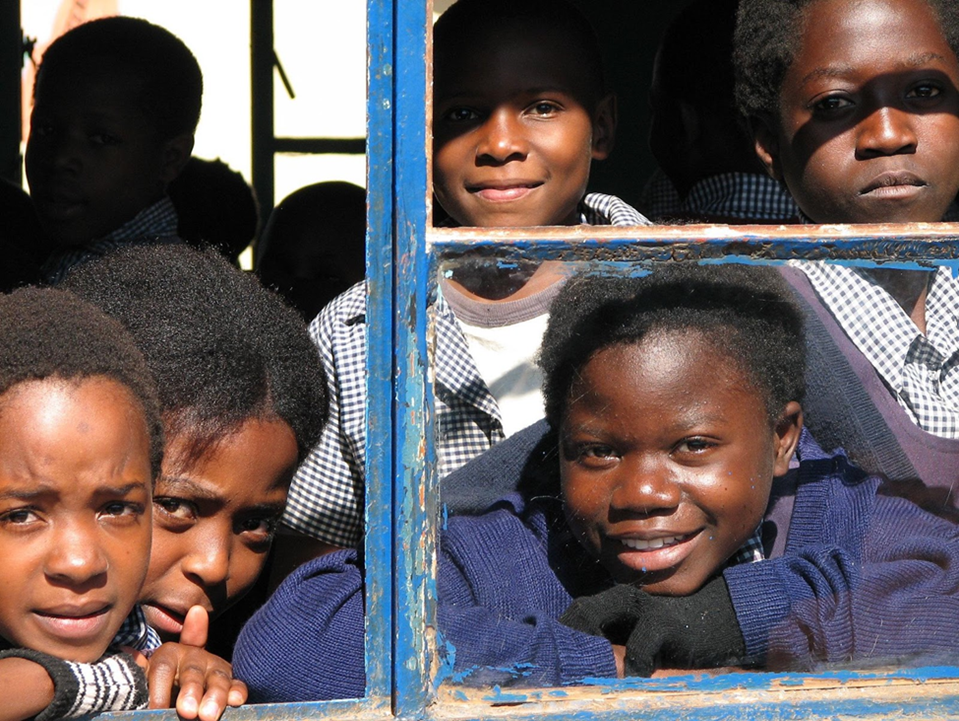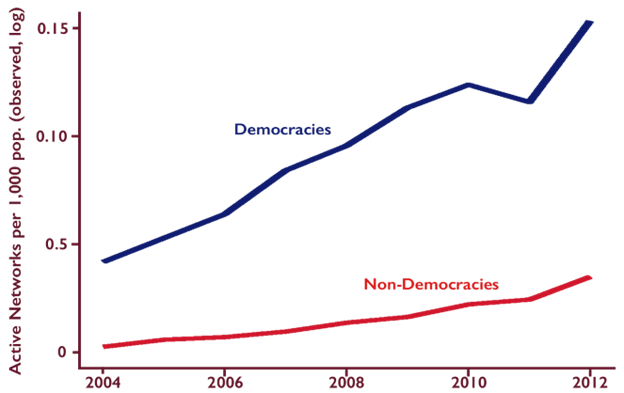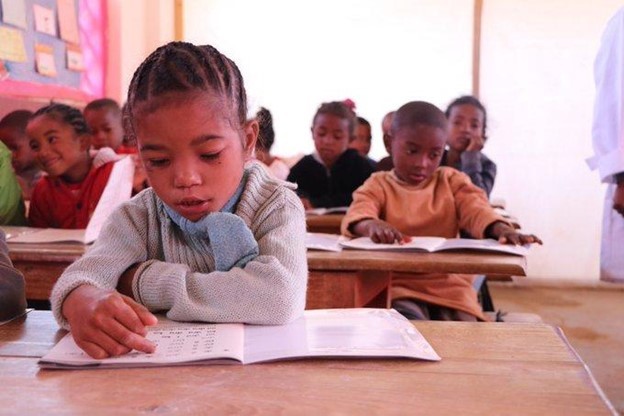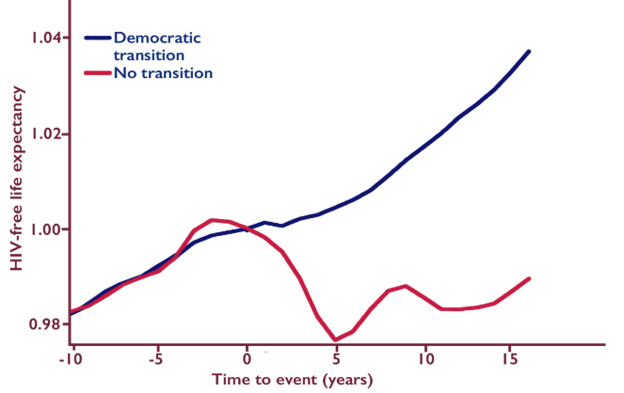|
President Biden opened the December 2021 Summit for Democracy by challenging the United States and its partners to continue to prove that democracy is “the best way to unleash human potential and defend human dignity and solve big problems.” For more than 30 years, USAID has promoted political freedom as an integral part of development. USAID's Democracy, Human Rights, and Governance (DRG) Strategy recognizes that support for DRG is essential to achieve the world’s broader social and economic development goals.
Bolstered by decades of research, in November 2021 Varieties of Democracy (V-Dem) launched their Case for Democracy campaign. The campaign is motivated by global democratic backsliding over the last 20 years – often called the “third wave of autocratization.” The Case for Democracy campaign seeks to outline and promote the social, economic, and security benefits of a more democratic world as well as reveal the tangible costs of democratic backsliding. The campaign has published eight policy briefs to highlight democracy’s impact on key development outcomes, including public goods, social protection, economic growth, and health.
 Students look out a classroom window at Regiment Basic School in Lusaka, Zambia, where USAID helped provide access to clean, safe water as part of a wide collaboration with the democratizing nation’s Ministry of Education. Photo: Chris Thomas/USAID
This edition of the DRG Learning Digest examines V-Dem’s findings on questions related to the provision of public goods and services:
- Does democracy improve public goods provision?
- Are democracies better for social protection of the poor, gender equality, and social cohesion?
- Does democracy have dividends for education?
- Does democracy increase global health?
Please make use of DRG Evidence and Learning Team resources! (See text box at the end.)
Providing public goods – services available to all members of a society that no single member has an incentive to provide – is a key role of all governments. An electrical grid, running water, good schools, paved roads, and public hospitals are all public goods that can enhance the lives of citizens. If democracies provide more public goods more effectively than non-democracies, then democratic backsliding will have serious material consequences for global quality of life.
Democracies provide public goods, including paved roads, safe water, environmental protections, public health, and public schooling, at higher rates than non-democracies. They also provide these public goods more equitably. In a study of electricity provision, researchers found that democracies not only electrified larger segments of their populations than autocracies, but that they were also more likely to electrify poor areas. The relationship holds even after controlling for differences in wealth, demographics, and geographic factors. Along with electricity, researchers found internet penetration increases at a much higher rate in democracies than autocracies.
 Democracies provide more public goods, like internet access, than non-democracies (V-Dem Policy Brief #33)
For development practitioners, this research not only validates efforts to promote democracy, but also offers insight into specific areas of focus across sectors. For example, democracies with strong vertical accountability mechanisms – such as high-quality elections – induce politicians to provide public goods and mitigate corruption. An evidence review conducted by USAID’s DRG Center found that democracies provide more public goods due to the relatively even distribution of political power compared to non-democracies. Since democratic governments require support from the majority of citizens, democratic governments enact policies that increase the provision of public goods to the majority of citizens. Not all sectors of democratic society will necessarily benefit equally, with the electoral majority benefiting the most. Further, there is also evidence that electoral considerations affect which types of public goods will be prioritized. Democratic politicians are more likely to provide those public goods that can be easily attributed to their actions. This may be a consideration for DRG officers when weighing the possibility of domestic resource mobilization or support for less visible, perhaps longer-term, priorities such as mitigating climate change or reducing gender-based violence.
“The true measure of any society can be found in how it treats its most vulnerable members.”
- Mahatma Gandhi
Democracies, by bringing the voice of the people directly into political discussions, are able to enhance spending on and protections of the vulnerable in society. In fact, social protection spending increases an average of 100 percent when a country transitions from a closed dictatorship to a full democracy. Evidence also shows that the strong relationship between democratization and increasing social protection is due to the vertical accountability mechanisms inherent in well-developed democracies. However, research finds that democracy is more effective at offering social protections when the level of corruption is low, making a focus on anti-corruption key to healthy democracies and societies. Research examining 173 countries from 1900 to 2015 has also demonstrated that while there is a slight increase with the initial stages of democratization, corruption levels curve downward as democratic freedoms grow strong — driven especially by effective vertical accountability that comes with high-quality, free, and fair elections.
Gender equality is much more likely to be the norm in democratic countries according to recent empirical studies. Flawed democracy leads to almost 33 percent lower levels of egalitarian gender attitudes compared to fully democratic countries, and hybrid as well as authoritarian regimes’ levels are more than 60 percent lower than those of democracies. The driving factor for egalitarian gender attitudes seems to be higher levels of high-quality education; however, education is much less likely to improve gender-equality attitudes in non-democratic countries. Further, long-term democratization affects more gender-equal representation. Studies have shown that “political and cultural factors rather than socioeconomic factors contribute to increased political participation of women and it is with high levels of democracy that political cultures are transformed.”
 Female leaders from democratic Ghana's Western Region take part in a USAID-supported workshop to increase their engagement with the local governance system.
The heightened focus on meeting the needs of all people also leads to more social cohesion. Democratic systems make the state more responsive to the people, which also shapes how people relate to each other, creating a more cohesive and trustful society. Research has found that people in democratic societies are more likely to cooperate for the common good. Collectively, the evidence suggests that healthy democracies offer better social protections and, at the same time, also foster more cohesive and cooperative societies. More on V-Dem’s findings on Democracy and Peace will be coming in December’s edition of the DRG Learning Digest.
Democracies also outperform non-democracies in providing equitable education and investment in education. Student enrollment is higher in democracies. The transition from a complete autocracy to a complete democracy is associated with a five-fold increase in student enrollment. This effect also translates into secondary education, with democracies having almost 70 percent higher enrollment in secondary education compared to autocracies. Overall, moving from a least to a most democratic system increases average schooling by 1.3 years.
In addition, democracies put more money toward education, and low- and middle-income children receive most of the benefits, as spending is moved from tertiary education to improving access to primary education for all pupils. The transition from autocracy to democracy corresponds with a 30 percent increase in total education expenditures as a share of GDP. Interestingly, some of this improvement can be linked to robust political participation; the more political parties there are representing the needs of the people, the more is spent on education. In Mexico, one study found a one percent increase in expenditure per student for each additional political party represented in the legislature. Increased spending can also include reduction or elimination of school fees. This translates into the greatest benefits for the poorer students, who experience a five percent increase in school attendance.
 USAID supported Madagascar’s education priorities by piloting a new approach to improve how Malagasy school children in grades 1-3 learn to read, through the “Mahay Mamaky Teny” approach. Photo: A.G. Klei
However, V-Dem’s briefer warns that although the increases in enrollment and funding are clear, the effect of democracy on quality of education is less clear, suggesting that particular emphasis needs to be put into education systems so that the greater number of children educated are also receiving the best education possible. One explanation offered by researchers Robin Harding and David Stasavage for these findings is that democracy is most effective because it creates vertical accountability between the parents and the government. And while this translates well into matters of education spending and attendance, parents may not always be well-placed to hold schools accountable for the quality of the education.
Research on the relationship between democracy and health outcomes is also unequivocal: democratic institutions, especially high-quality elections, improve health outcomes. Countries that transition to democracy increase life expectancy, reduce child mortality, and lower death from non-communicable diseases. Autocratization, meanwhile, deteriorates health outcomes. For countries that started autocratizing between 2000 and 2010, life expectancy at age five decreased by 1.3 percentage points, the universal health coverage index decreased by 8.7 percentage points, and out-of-pocket spending for medical services per capita increased by 5.6 percentage points. Health researchers have commented that “democratic erosion in recent years is hindering population health gains” and that global health outcomes could be improved by “increasing the funding for the development agency-led programmes for democracy promotion and governance.”
 Countries that transition to democracy improve life expectancy compared to very similar countries that remain non-democratic (V-Dem Policy Brief #29).
While democracies tend to experience greater economic growth than autocracies, the effect of democracy on health is not driven by income or gross domestic product. The changes in health outcomes depend on two key factors: credible elections and how long a country has been democratic. The higher the level of democracy and the longer the country has been a democracy, the greater the health effects. One key causal mechanism is health spending: democracies spend more money on public health. Citizens strongly desire improved health infrastructure, and democratic governments respond to those citizen desires.
Further Assistance
You can learn more in V-Dem’s Case for Democracy and other resources found in this Learning Digest, and by contacting Christopher Grady (cgrady@usaid.gov) and Levi Adelman (ladelman@usaid.gov), or the DRG Center’s Evidence and Learning Team (ddi.drg.elmailist@usaid.gov).
Recent DRG Learning Events
Evidence and Learning Talk Series: Delivering on Localization’s Promise
Dan Honig, Associate Professor at University College London, spoke to the DRG Center on November 10 about his work on development effectiveness (including his 2018 book, Navigation by Judgment). Dr. Honig argues that making localization more than cheap talk requires changing management practices, not just identities. He also argues that new accountability frameworks are needed to realize the benefits of localization, which can and should benefit development effectiveness.
Use Our Resources!
Welcome to the DRG Learning Digest, a newsletter to keep you informed of the latest learning, evaluation, and research in the Democracy, Human Rights, and Governance (DRG) sector. Views expressed in the external (non-USAID) publications linked in this Digest do not necessarily represent the views of the United States Agency for International Development or the United States Government.
Don't forget to check out our DRG Learning Menu of Services! (Link only accessible to USAID personnel.) The Menu provides information on the learning products and services the Evidence and Learning Team offers to help you fulfill your DRG learning needs. We want to help you adopt learning approaches that emphasize best fit and quality.
The Evidence and Learning Team is also excited to share our DRG Learning, Evidence, and Analysis Platform (LEAP) with you. This Platform contains an inventory of programmatic approaches, evidence gap maps, the DRG Learning Harvest, and inventories of indicators and country data portraits - all of which can be very useful in DRG activity design, implementation, evaluation, and adaptation. Some of these resources are still being built, so check back frequently to see what has been newly added.
The DRG Learning Harvest on LEAP is a searchable database of DRG learning products, including summaries of key findings and recommendations, drop-down menus to easily find documents related to a particular country or program area, and links to the full reports on the DEC.
Our friends at the Varieties of Democracy (V-Dem) Institute are also seeking to expand their research partnership with USAID on the complex nature of democracy by inviting research questions from you for V-Dem to work on. If there's a DRG technical question you've been wondering about, please email the Evidence and Learning Team at ddi.drg.elmaillist@usaid.gov.
We welcome your feedback on this newsletter and on our efforts to promote the accessibility, dissemination, and utilization of DRG evidence and research. Please visit the DRG Center's website for additional information or contact us at ddi.drg.elmaillist@usaid.gov.
|